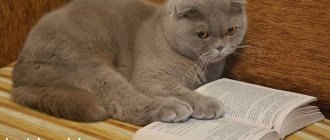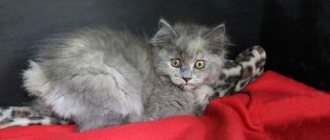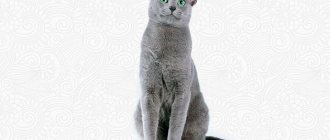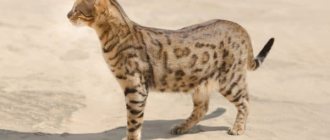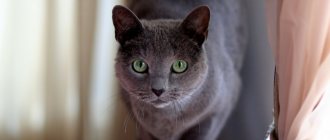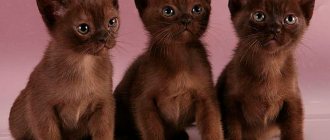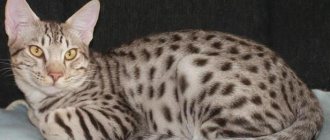- April 17, 2019
- Cats
- Victor Sobolev
The Blue Scottish Fold, otherwise known as the Scottish Fold, is a beautiful breed with a little quirk. Her ears are lowered down, but do not cause any discomfort to the animal. Blue Scottish Fold cats are very beautiful and very popular. As is typical of a true Scot, Scottish Folds are surprisingly calm, intelligent and are able to give their owner irreplaceable comfort in the home. In this article you can learn about the standard of the Scottish Fold cat breed, the characteristics of the animal, its character and possible difficulties.
Breed standard
This is a medium-sized animal, belonging to the short-haired type, with curled ears. Moreover, babies are born with straight ears, but after a few weeks they droop. The coat of a Scottish Fold cat is short and thick, with a pleasant softness to the touch. The body build is dense and powerful. The legs are of medium length, with large pads on the paws. The eye color of blue Scottish Fold cats is usually almond-shaped. In kittens they may be a different color, which will change over time. The weight of the pet varies from 3 to 6 kilograms, depending on gender. The size of the Scottish Fold cat is approximately 28-30 cm.
How do kittens' eyes change?
The final eye color in cats is established by the age of 2 years. The process of changing the color of the iris is called reblooming. Most often it begins in the 4th week of a kitten’s life. In this case, the usual blue tint of the eyes is diluted with splashes of a different color. Gradually, these inclusions grow and the animal’s eyes acquire a constant shade.
So, if you have a preference for cats with a certain eye color, adopt a kitten at 4 months of age. At this time, it is already possible to determine what color of the pet’s iris will be. Later it may acquire greater depth and richness, but its basic tonality will remain unchanged. It is worth noting that eye color is not a feature of a particular breed. This is a purely genetic criterion, where blue color is a recessive trait.
The color of the animal depends on the accumulation of melanin pigment. There is more of it in the fur, and less in the eye area. The absence of a coloring component is indicated by the blueness of the organs of vision. The phenomenon is typical for albinos. However, the transformation of the visual organs is also associated with age-related changes.
Age-related changes
Up to two weeks, the color of the cub's eyes is masked by a grayish film. In a growing kitten, pigment accumulates, so the color of the iris changes. The following eye colors are typical for cats:
- bluish;
- green;
- yellow;
- orange (copper).
The main tone of the kitten's eye color is formed by 17 weeks. It is at this age that a breeder should purchase a breeding animal.
Breed differences
The color of the iris is a sign of a purebred cat. For some breeds, eye color does not matter. Others - with atypical coloring - are excluded from breeding. Blue eyes are characteristic of albinos of different breeds. A distinctive feature of the British is the orange iris. For black solids, any color except green is acceptable. The standard for Siamese and Thai cats is blue.
Description of the blue Scottish fold cat
As a rule, it is believed that there are practically no incidents with these beautiful creatures. By nature, blue Scottish Fold cats are quite calm and affectionate. As children, they quickly get used to a new place and household thanks to their natural friendliness. They love their owners so much that they are ready to follow them on their heels, while doing so unobtrusively. The Scots have a stable and balanced psyche. They get along well not only with children and animals, but even with strangers. Scottish Fold cats have normal health and cleanliness.
As with any other living beings, there are some problems with the Scots. This usually occurs when the cat is still young and full of energy. Young Scottish Folds are very active and can run around rooms for hours. But adult individuals have a phlegmatic disposition and would rather sit on their owner’s lap than play and run around.
Dimensions and weight
The breed has a medium sized body. Their length is approximately 55cm. Height in a standing position on fours is 30 cm.
The average Scottish Fold blue cat weighs less than an adult cat. The weight of an adult is approximately 3–5 kg, more often 3.5–4.5 kg. The cat's weight reaches 4-5 kg, sometimes 6-7 kg. The cat has a larger head and powerful paws.
Anatomical characteristics
The breed has the following characteristics:
• Round head, high forehead, strong massive chin, short wide nose, full cheeks.
• Ears curved forward and down, small to medium in size with pointed tips.
• The eyes are round, expressive, and set wide apart.
• Body of medium size, muscular neck, pronounced shoulders, developed chest.
• Limbs with small round paws and movable toes are proportional to the overall build.
• The tail is wide at the base and gradually tapers towards the tip. It is flexible and medium in size
Scottish fold cost
The price of a kitten depends on what the future owners plan to get a pet for. For people for whom it is fundamentally important to get a purebred show-class kitten for its subsequent participation in exhibitions, the cost will be at least 50 thousand. If they buy a baby just for the soul and its origin is not so important for the family, then it is quite possible to purchase an animal for between 10-30 thousand rubles. The Blue Scottish Fold cat is a fairly common breed. You can buy it in almost any city.
Genetics of black smoke color
To get black smoke, a cat must have not only the gene for black coat color B and pigment density D, but also the smoky color inhibitor gene, which blocks the synthesis of pigment in the cells of the hair follicles. As a result of its action, only the upper part of the guard hair is painted, and the root part remains devoid of pigment. As soon as the hair stops growing, i.e. reaches its maximum, the inhibitor gene I (from the word “inibitor”) stops acting on this hair.
However, the inhibitor gene in combination with the gene for density and black pigment is not enough for the animal to be smoky. Such individuals also have non-agouti (aa) genes, that is, genes for non-patterned (non-tabby) colors. The combination of aaII (or aaIi) genes produces haze.
Blue Scottish Fold cat: care and maintenance features
The little Scottish Fold is a real livelier, bursting with energy. When a new family member arrives, you will need to buy the following supplies for his comfortable living in the house:
- two bowls - for food and drink;
- toys - to distract the baby’s attention and not play with him with his hands;
- scratching post;
- combing brush;
- tray;
- basket or sleeping mat.
Before the kitten arrives, you should remove all objects that are dangerous to it: sockets, wires and small things that it could accidentally swallow.
The house must be clean so that the little fragile creature does not get sick.
Keeping a blue Scottish Fold cat will cost owners no more than any other breed.
It's easy to care for. To keep the fur looking neat, it is enough to brush your pet two to three times a week. During the molting period, the procedure is carried out more often.
Ears, eyes and nose should always be clean. If any discharge appears, it should be removed immediately using a cotton pad soaked in water. You need to bathe your cat no more than once every six months.
To the peculiarities of caring for a blue Scottish fold cat, we can add that these creatures are sometimes susceptible to diseases of the joints, eyes and skin. For this reason, you need to closely monitor the animal.
Primary colors
Today, the number of Scottish Fold colors includes about a hundred variations. Moreover, the color of a Scottish cat’s coat is not immediately established. At six months the kitten will have its first molt, after which the baby fur will change to an adult one. Later, the color may change slightly and is finally established only by two years.
Scots have 2 main genes that are responsible for the red and black coat colors. In addition, there is a third gene called diluent, which determines the saturation of the pigment. One of the two main genes takes over, the combination occurs in a different order, resulting in different colors in Scottish Folds.
It is because of this play of genes that the black color turned out to be bluish, the chocolate color turned into lilac, and so on. Even when forming a color, such indicators as the degree of coloring of each hair hair and the presence of spots and patterns are important. Among the Scottish Folds there are also pure white individuals. This means that they lack the gene responsible for color and the suppression of the gene for this color by other genes.
Plain
These colors of cats are characterized by uniform coloring of the coat. If there are inclusions, then this color is classified as non-uniform. Due to the presence of such a small defect, the price of a kitten is reduced. This group includes:
- blue;
- white;
- chocolate;
- lilac;
- black – ebony;
- faun;
- red;
- cinnamon – reminiscent of the color of cinnamon;
- cream or peach.
Two-color or bicolor
The coat color of these feline representatives consists of two parts: one is white, and the second is one of the same colors or striped. Ideally, the pattern should be located symmetrically on the cat's body.
Point
The color in this case resembles the coloring of Siamese cats, that is, the main body color is always light, and the mask, ears, tips of the paws and tail are darker. There are subspecies with lilac, chocolate, cream blue and even tortoiseshell splashes. This color occurs due to a special gene that darkens areas of the body with a lower temperature.
Torties or tortoiseshells
The name of this rare color comes from the English word "turtle". The color is formed by spots of dark, red or cream colors. They come in black or chocolate-red, blue or lilac-cream. At the same time, the colors are distributed evenly, so they should not be confused with calico cats. Normally, this coloring occurs only in females. If a male Scottish Fold tortoiseshell is born, then this is the result of a mutation, and he will not bear offspring.
Smoky
The coloring suggests that the hairs have a uniform color along almost the entire length, and become lighter at the base. The color of the hairs, when they have part of a silver-white color and part of any other shade, is called tipping. The dominant gene for silver color is responsible for it.
Tabby
Everyone's favorite minke whales are also among the Scottish Folds. They are characterized by a “crown” pattern on the head, highlighting at the back of the ears, a border around the eyes and nose, stripes on the neck, paws and tail. Tabbies are divided into different subspecies:
- brindle;
- leopard print;
- marble.
By color pigment, tabbies are classified as follows:
- silver with a black pattern;
- silver-blue with a whitish undercoat;
- blue – there is a blue pattern on a creamy blue background;
- brown with black stripes, spots or stains;
- cream;
- red;
- cameo tabby, suggesting a red pattern on a white background.
They combine two colors at once: white and tortoiseshell.
Chinchilla
In this color, the tipping effect takes the following form: only one-eighth of the hair is colored dark, and the rest is white. Among them the following varieties are distinguished:
- silver;
- gold;
- blue golden is the rarest type of color.
The ticking effect involves dyeing the hairs not in two, but in three colors at once.
Shaded
In them, the pigment colors only the very tip of the hairs, and the rest of the hair is white. There is a light undercoat, a shaded part of the hair fibers in certain areas of the body - at exhibitions, experts evaluate how evenly and correctly it is located. The presence of signs of a tabby pattern is prohibited. They are divided into:
- red;
- silver;
- golden.
Wang
Their color combines a white body with a tail and muzzle of a darker shade, possibly interspersed with several spots with a plain or tabby pattern.
Harlequin
These are white individuals with a dark tail, as well as spots that are not located next to each other, but are distributed throughout the body. Such animals look very colorful, which is why they got such an interesting name.
What should you teach your cat?
All pets must be trained to a certain discipline. A cat is not a dog, and it is unlikely that it will unquestioningly follow commands to please its owner. But even such an independent and freedom-loving creature must know the norms of behavior - what can be done and what cannot be done.
Thanks to their high intelligence and quick wit, blue Scottish Fold cats grasp everything literally on the fly, and raising an exemplary pet who will fill life with only joyful moments will not be difficult.
So, what should a domestic cat know and be able to do?
Caring for smoke-colored cats
Smoky cats are very demanding in care, because... In unkempt animals, the fur becomes discolored, fades, and “rusts.” Care means not only regular brushing and combing of the coat, but also a balanced diet, and also protection from frequent, prolonged exposure to sunlight.
It is recommended to wash black show cats with professional shampoos that enhance the black color. And, oddly enough, it is better to wash black smoky cats with whitening shampoos for white cats. The enzymes contained in such shampoos perfectly whiten the root zone, and make the ends of the hair appear shiny.
In addition to shampoo, when grooming, you can use a balm to volume the coat. Then the hairs will be raised and show off the haze more favorably.
You also need to carefully monitor traces of tears, which dry up and become crusts, and after they are removed, if you clean the area around the eyes irregularly, yellowish spots may remain. It will take a long time to get them out. Therefore, it is better to regularly use cleansing eye lotions for preventative purposes as tear stains appear.
Long-haired smoke-colored Scots need to be brushed frequently to prevent mats from forming. If in cats of a different color the tangles can simply be cut out, then in smoky cats such manipulation will lead to dark guard hairs growing in place of the light undercoat - a dark spot will appear on the body.
Furminators are also not suitable for combing such cats. The fact is that the furminator can damage the undercoat - the result can be as disastrous as in the case of cutting out the mat. Also, such cats should never be trimmed. It is better to bathe thoroughly during molting and comb it either with a regular comb with fairly sparse teeth, or with a special silicone paw.
And, of course, one should not allow heavy or prolonged shedding in smoky animals, so that they do not lose their undercoat, which forms all the beauty, and also so that the coat does not fade. In order for molting to be less intense, a balanced diet and vitamin intake in courses are necessary if the cat is on a natural diet or on non-vitaminized factory feed.
Sharpen your claws only on a scratching post
Claws are an important attribute of any cat. With their help, the animal climbs trees and other surfaces, and also uses them as a means of defense. Sharpening claws, doing a kind of manicure, is a natural need for a pet. Unknowingly, cats begin to tear up everything that gets in their way: furniture, carpets, wallpaper. To avoid this, you need to accustom your pet to order. Every time a cat starts sharpening its claws in an inappropriate place, immediately pick up the animal and bring it to the scratching post. This needs to be repeated several times. Gradually, the animal learns to sharpen its claws where it is needed.
Wang
The Van coloring of Scottish pets includes a white coat with a colored tail and several spots on the head. If there are large spots on the paws and back, this is considered an undesirable sign for a purebred Scot. And a cat with dark red patterns is called a red van.
The color of the spots can be single-color or tabbed.
Pet health
In general, cats of this breed have good health, but are sometimes susceptible to certain diseases. Often, pets suffer due to improper mating when Scottish Folds are mated with each other, which is absolutely forbidden to do. The list of common diseases includes:
- entropion of the eyelid;
- allergy;
- deafness.
In addition to the above diseases, Scots in adulthood have problems with the digestive tract and the functioning of the cardiovascular system. To avoid them, you need to monitor your pet’s condition and take him to the veterinarian more often.
Nutrition
In order for your pet to be strong and healthy, nutrition must be regular and balanced. The best option is a diet based on natural ingredients. Can be fed with dry food. Experts advise using a varied diet that contains both bagged cat food and natural ingredients.
Regular drinking is mandatory. Water must be constantly replenished. Adults should receive food 2-3 times a day. Often there is no need to change types of food, as the stomach may ache. There is no need to eat foods with large amounts of fat, vinegar, salt, or sugar. Food should not be too hot or cold. The diet should include lean meat, fish, milk, and cottage cheese. It is not advisable to give onions, garlic, tomatoes, eggplants.
What to feed?
To keep your pet happy and healthy, you need to carefully monitor its diet. If the owner plans to feed the cat natural food, then his diet should include the following products:
- meat (beef, turkey, veal);
- boneless fish;
- offal (boiled);
- vegetables;
- eggs.
It is not recommended to feed cats raw, unprocessed meat to avoid infection with helminths. Also, do not give your pet milk. It is useful only for small kittens, but not for adult animals.
Products prohibited for cats include:
- sweets;
- alcohol;
- fatty and fried foods;
- smoked meats
Such food is not only not healthy for the animal, but can also have a detrimental effect on its health and body function.
If the owner decides to feed the pet prepared food, then preference should be given to well-known premium companies, such as Royal Canin or Purina. Scottish Folds happily eat both wet and dry food.
Your cat should always have a bowl of clean, fresh water.
Two-color
A unique coat color is bicolor (two-color cats). The main background is snow-white. The second color in color (cream, black, blue, red) is presented in the form of unusual patterns. Thoroughbred representatives must have white belly, neck, chest, paws, muzzle and beard.
A prerequisite is the predominance of a white background in color. Bicolors are more valued; their body patterns are symmetrical. The eyes can be any shade, but are usually blue or golden yellow.
Cream bicolor
Cute white cats with additional streaks of delicate cream tones. The eyes are blue or yellow, and the nose and pads are pink.
Blue bicolor
The pattern on the wool is blue (delicate or rich gray). The iris of the eyes is a beautiful sky tone or yellow-orange. The nose and paws below are pink.
Black bicolor
Black and white bicolor is characterized by patterns of rich black tone. These cats have a pink nose and blue or copper eyes. A symmetrical, distinct pattern on the skin turns the cat into a real gentleman in a tailcoat.
Difficulties with Scottish Folds
Scottish Folds are peaceful and affectionate creatures. They love their owner and all family members. There are no particular difficulties with keeping Scottish cats. In childhood, kittens are overly active and can cause some trouble for household members, but with age, the playful baby turns into an important and phlegmatic cat. Fold-eared cats are perfect for families with children and for retirees, but they definitely won’t fit into the environment of people who lead an active lifestyle. Scots shed actively several times a year, and during this period you will have to clean more often. Another problem with keeping a blue fold cat is its insatiable appetite. Especially in castrated and neutered animals. To prevent your pet from gaining excess weight, you need to control your food intake.
In general, turning a blind eye to some difficulties, we can say that the Scottish Fold is a wonderful pet.
Chinchilla
The Scottish chinchilla borrowed the extravagant colors of its coat from the British, and they, in turn, from Persian cats. A chinchilla kitten is born only from parents with an unusual color. Each hair is colored in two colors.
Most of it is light in color and 1/8 of it (the top) is dark in color. This phenomenon is called tipping.
Tipped chinchilla colors can be of 3 types:
Owners' opinion
Owners of Scottish Folds often leave comments about their pets. Most owners speak positively about their favorite plush cats. As a rule, they are balanced, intelligent and beautiful. The Scots are kind to all people and animals. But owners often write about problems associated with this breed. These include high activity of the pet at a young age, disobedience, ignoring family members, damage to furniture and fragile health.
Often, most of the problems that a cat creates are the fault of the owner himself, who did not react in time and did not show the pet how to behave correctly. When it comes to health, you need to carefully monitor the condition of the animal and not leave the situation to chance.
Scottish Folds are the smartest and most graceful creatures that, with proper training and care, will be excellent pets.
Shaded (shedded) colors
An unusual definition refers to the interesting color of Scottish cats - shaded colors. These pets have almost white fur, but the tip of the guard hair is colored.
The top layer of a cat's coat can be any shade typical of Scottish cats. The undercoat is white. The sides, back, head, tail and ears are shaded. Light belly, chin and lower tail. There should be no obvious spots. The “M” sign on the forehead and darkish rings on the paws are acceptable.
Shedded colors can be of three varieties:



